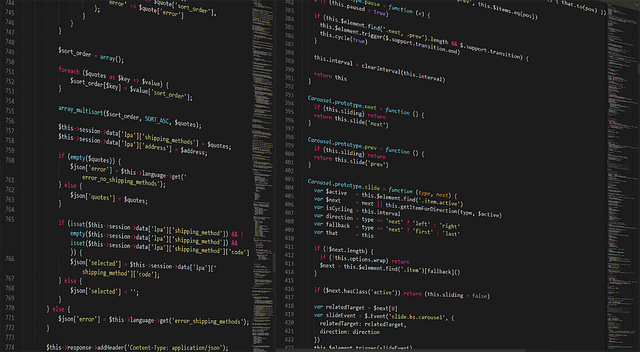この記事では、JavaScriptのFetch APIの基本的な使い方から実践的な応用まで包括的に解説しています。GETやPOSTリクエストの送信方法、ヘッダー設定、レスポンス処理、エラーハンドリングなど、Web APIとの通信に必要な技術を具体的なコード例とともに学べます。外部データの取得や送信でつまずいている開発者や、非同期通信の実装方法を体系的に理解したい方の悩みを解決できる実用的な内容です。
目次
JavaScript Fetch APIの基本概要

Fetch APIとは何か
Fetch APIは、現代のJavaScriptにおいてHTTPリクエストを送信するための標準的なWebAPIです。このAPIは、ウェブサーバーとの非同期通信を簡潔で直感的な方法で実現し、開発者にとってより使いやすいインターフェースを提供しています。
Fetch APIの最大の特徴は、Promiseベースの設計により非同期処理を効率的に扱えることです。従来の複雑なコールバック関数から解放され、async/awaitと組み合わせることで、より読みやすく保守性の高いコードを記述できます。また、RequestとResponseオブジェクトを使用したオブジェクト指向的なアプローチにより、リクエストとレスポンスの詳細な制御が可能になります。
さらに、Fetch APIはストリーミング処理にも対応しており、大容量のデータを効率的に処理できる点も重要な利点です。RESTful APIとの連携やSPA(Single Page Application)の開発において、JavaScript fetchは現在最も推奨される方法となっています。
従来のXMLHttpRequestとの違い
XMLHttpRequestとFetch APIには、設計思想と実装方法において根本的な違いがあります。これらの違いを理解することで、なぜFetch APIが現代の開発において優先されるのかが明確になります。
まず、API設計の違いについて、XMLHttpRequestはイベントベースのAPIであり、onreadystatechangeやonloadといったイベントハンドラーを使用します。一方、Fetch APIはPromiseベースの設計により、then()やcatch()メソッド、またはasync/awaitを使用した直線的なコード記述が可能です。
コードの可読性においても大きな差があります。XMLHttpRequestでは複数のステップに分かれた設定が必要で、コールバック地獄に陥りやすい構造でした。Fetch APIでは、リクエストの送信から結果の処理まで一連の流れを自然な形で表現できます。
- エラーハンドリングの改善:XMLHttpRequestでは複数のエラーイベントを個別に処理する必要があったが、Fetch APIでは統一的な例外処理が可能
- デフォルト設定の最適化:CORS対応やJSON処理など、現代のWeb開発に必要な機能がデフォルトでサポート
- ヘッダー管理の簡素化:Headersオブジェクトによる直感的なHTTPヘッダーの操作
- レスポンス処理の柔軟性:様々なデータ形式(JSON、Blob、ArrayBufferなど)への統一的な変換メソッド
ブラウザ対応状況とサポート範囲
JavaScript fetchの実用性を判断する上で、ブラウザ対応状況の把握は極めて重要です。現在のFetch APIは、主要な現代ブラウザにおいて広くサポートされており、実用的な開発において安心して使用できる状況にあります。
デスクトップブラウザにおいては、Chrome 42以降、Firefox 39以降、Safari 10.1以降、Edge 14以降でFetch APIがネイティブサポートされています。これらのバージョンは現在では十分に普及しており、一般的なWebアプリケーションにおいて問題となることはほとんどありません。
モバイルブラウザでも同様に良好な対応状況を示しており、iOS Safari 10.3以降、Android Chrome 42以降で完全にサポートされています。これにより、モバイルファーストの開発アプローチにおいてもFetch APIを安心して採用できます。
| ブラウザ | サポート開始バージョン | 現在の対応状況 |
|---|---|---|
| Chrome | 42.0 | 完全対応 |
| Firefox | 39.0 | 完全対応 |
| Safari | 10.1 | 完全対応 |
| Edge | 14.0 | 完全対応 |
レガシーブラウザのサポートが必要な場合は、polyfillの導入を検討する必要があります。GitHub上で公開されているwhatwg-fetchなどのpolyfillを使用することで、古いブラウザでもFetch APIの機能を利用できます。ただし、polyfillを使用する際は、パフォーマンスへの影響とファイルサイズの増加を考慮した判断が重要です。
Fetch APIの基本的な使用方法

JavaScript Fetch APIを使用してWebアプリケーションでHTTPリクエストを行う際の基本的な実装方法について解説します。Fetch APIはPromiseベースの設計により、直感的で読みやすいコードでサーバーとの通信を実現できます。以下では、最も頻繁に使用される基本的なパターンから、実際の開発でよく必要になる具体的な実装方法まで、段階的に学習していきます。
基本的なGETリクエストの実装
Fetch APIで最も基本となるGETリクエストの実装方法を説明します。fetchメソッドは引数にURLを受け取り、Promiseを返すシンプルな構造になっています。
fetch('https://api.example.com/users')
.then(response => {
if (!response.ok) {
throw new Error(`HTTP error! status: ${response.status}`);
}
return response.text();
})
.then(data => {
console.log(data);
})
.catch(error => {
console.error('エラーが発生しました:', error);
});より現代的なasync/awaitを使用した書き方では、以下のようになります:
async function fetchData() {
try {
const response = await fetch('https://api.example.com/users');
if (!response.ok) {
throw new Error(`HTTP error! status: ${response.status}`);
}
const data = await response.text();
console.log(data);
} catch (error) {
console.error('エラーが発生しました:', error);
}
}重要なポイントとして、fetch()は404や500エラーではPromiseが拒否されないため、response.okプロパティを使用してステータスコードの確認が必要です。
JSONデータの取得と処理
Web APIとの連携で最も頻繁に使用されるJSONデータの取得と処理について詳しく解説します。JSONデータを扱う場合は、response.json()メソッドを使用してレスポンスをJavaScriptオブジェクトに変換します。
async function fetchUsers() {
try {
const response = await fetch('https://jsonplaceholder.typicode.com/users');
if (!response.ok) {
throw new Error(`HTTP error! status: ${response.status}`);
}
const users = await response.json();
console.log('取得したユーザー数:', users.length);
users.forEach(user => {
console.log(`ID: ${user.id}, Name: ${user.name}, Email: ${user.email}`);
});
} catch (error) {
console.error('JSONデータの取得に失敗しました:', error);
}
}複雑なJSONデータの処理では、レスポンスの構造を事前に確認し、適切なエラーハンドリングを実装することが重要です:
async function fetchUserDetail(userId) {
try {
const response = await fetch(`https://api.example.com/users/${userId}`);
if (!response.ok) {
throw new Error(`ユーザーの取得に失敗: ${response.status}`);
}
const userData = await response.json();
// データの構造チェック
if (!userData.id || !userData.name) {
throw new Error('無効なユーザーデータです');
}
return {
id: userData.id,
name: userData.name,
email: userData.email || 'メールアドレスなし',
profile: userData.profile || {}
};
} catch (error) {
console.error('ユーザー詳細の取得エラー:', error);
return null;
}
}画像やバイナリデータの取得
Fetch APIを使用して画像ファイルやその他のバイナリデータを取得する方法について説明します。バイナリデータの場合は、response.blob()メソッドやresponse.arrayBuffer()メソッドを使用してデータを処理します。
画像データの取得と表示の実装例:
async function fetchAndDisplayImage(imageUrl, imgElement) {
try {
const response = await fetch(imageUrl);
if (!response.ok) {
throw new Error(`画像の取得に失敗: ${response.status}`);
}
const imageBlob = await response.blob();
const imageObjectURL = URL.createObjectURL(imageBlob);
imgElement.src = imageObjectURL;
imgElement.onload = () => {
// メモリリークを防ぐためにオブジェクトURLを解放
URL.revokeObjectURL(imageObjectURL);
};
} catch (error) {
console.error('画像の読み込みエラー:', error);
imgElement.src = 'placeholder.png'; // フォールバック画像
}
}ArrayBufferを使用したバイナリデータの処理:
async function downloadFile(fileUrl, fileName) {
try {
const response = await fetch(fileUrl);
if (!response.ok) {
throw new Error(`ファイルのダウンロードに失敗: ${response.status}`);
}
const arrayBuffer = await response.arrayBuffer();
const blob = new Blob([arrayBuffer]);
// ダウンロードリンクを作成
const downloadUrl = URL.createObjectURL(blob);
const link = document.createElement('a');
link.href = downloadUrl;
link.download = fileName;
link.click();
// クリーンアップ
URL.revokeObjectURL(downloadUrl);
} catch (error) {
console.error('ファイルダウンロードエラー:', error);
}
}URLパラメータとクエリの設定
動的なWebアプリケーションでは、URLにパラメータやクエリストリングを含めてデータを取得することが頻繁にあります。JavaScriptのURLクラスやURLSearchParamsクラスを組み合わせることで、効率的にパラメータを管理できます。
URLSearchParamsを使用したクエリパラメータの構築:
async function fetchUsersWithParams(filters) {
const baseUrl = 'https://api.example.com/users';
const params = new URLSearchParams();
// フィルタ条件をパラメータに追加
if (filters.name) {
params.append('name', filters.name);
}
if (filters.age) {
params.append('age', filters.age);
}
if (filters.department) {
params.append('department', filters.department);
}
// ページネーション
if (filters.page) {
params.append('page', filters.page);
}
if (filters.limit) {
params.append('limit', filters.limit);
}
const url = `${baseUrl}?${params.toString()}`;
try {
const response = await fetch(url);
if (!response.ok) {
throw new Error(`データの取得に失敗: ${response.status}`);
}
const result = await response.json();
return result;
} catch (error) {
console.error('フィルタされたユーザーデータの取得エラー:', error);
return { users: [], total: 0 };
}
}より複雑なクエリ構築の例:
function buildApiUrl(endpoint, params = {}) {
const url = new URL(endpoint);
Object.entries(params).forEach(([key, value]) => {
if (value !== null && value !== undefined && value !== '') {
if (Array.isArray(value)) {
// 配列の場合は複数のパラメータとして追加
value.forEach(item => url.searchParams.append(key, item));
} else {
url.searchParams.set(key, value);
}
}
});
return url.toString();
}
// 使用例
async function searchProducts(searchParams) {
const apiUrl = buildApiUrl('https://api.example.com/products', {
q: searchParams.query,
category: searchParams.categories, // 配列
minPrice: searchParams.minPrice,
maxPrice: searchParams.maxPrice,
sortBy: searchParams.sortBy,
page: searchParams.page || 1,
limit: searchParams.limit || 20
});
try {
const response = await fetch(apiUrl);
return await response.json();
} catch (error) {
console.error('商品検索エラー:', error);
return { products: [], totalCount: 0 };
}
}URLSearchParamsとURLクラスを組み合わせることで、複雑なクエリパラメータも安全にエンコードされ、保守しやすいコードが実現できます。
HTTPリクエストメソッドの実装

JavaScript Fetch APIを活用する際、適切なHTTPリクエストメソッドを選択することで、サーバーとの効率的な通信が実現できます。それぞれのメソッドには明確な役割があり、RESTful APIの設計原則に従って使い分けることが重要です。以下では、主要なHTTPメソッドの実装方法について詳しく解説していきます。
GETメソッドによるデータ取得
GETメソッドは、サーバーからデータを取得する際に使用する最も基本的なHTTPメソッドです。fetch関数では、メソッドを指定しない場合、デフォルトでGETリクエストが送信されます。
// 基本的なGETリクエスト
fetch('https://api.example.com/users')
.then(response => response.json())
.then(data => console.log(data))
.catch(error => console.error('エラー:', error));
// メソッドを明示的に指定
fetch('https://api.example.com/users', {
method: 'GET',
headers: {
'Content-Type': 'application/json',
'Authorization': 'Bearer your-token-here'
}
})
.then(response => {
if (!response.ok) {
throw new Error(`HTTP error! status: ${response.status}`);
}
return response.json();
})
.then(data => {
console.log('取得したデータ:', data);
});GETリクエストでは、パラメータはURLのクエリ文字列として渡します。URLSearchParamsを使用することで、パラメータの管理が簡潔になります。
// クエリパラメータを含むGETリクエスト
const params = new URLSearchParams({
page: 1,
limit: 10,
sort: 'created_at'
});
fetch(`https://api.example.com/users?${params}`)
.then(response => response.json())
.then(data => console.log(data));POSTメソッドによるデータ送信
POSTメソッドは、新しいデータをサーバーに送信する際に使用します。リクエストボディにデータを含めて送信するため、GETメソッドとは異なる設定が必要です。
// JSONデータをPOSTで送信
const userData = {
name: '山田太郎',
email: 'yamada@example.com',
age: 30
};
fetch('https://api.example.com/users', {
method: 'POST',
headers: {
'Content-Type': 'application/json',
},
body: JSON.stringify(userData)
})
.then(response => {
if (!response.ok) {
throw new Error(`HTTP error! status: ${response.status}`);
}
return response.json();
})
.then(data => {
console.log('作成されたユーザー:', data);
})
.catch(error => {
console.error('エラー:', error);
});フォームデータを送信する場合は、FormDataオブジェクトを使用することで、multipart/form-data形式での送信が可能です。
// FormDataを使用したPOSTリクエスト
const formData = new FormData();
formData.append('name', '田中花子');
formData.append('email', 'tanaka@example.com');
formData.append('avatar', fileInput.files[0]); // ファイルも含める場合
fetch('https://api.example.com/users', {
method: 'POST',
body: formData // Content-Typeヘッダーは自動設定される
})
.then(response => response.json())
.then(data => console.log(data));PUT・DELETEメソッドの使い方
PUTメソッドは既存データの更新に、DELETEメソッドはデータの削除に使用します。これらのメソッドを適切に実装することで、RESTful APIとの完全な連携が可能になります。
PUTメソッドの実装例では、既存のリソース全体を新しいデータで置き換える処理を行います。
// PUTメソッドによるデータ更新
const updatedUserData = {
id: 123,
name: '佐藤次郎',
email: 'sato@example.com',
age: 35
};
fetch('https://api.example.com/users/123', {
method: 'PUT',
headers: {
'Content-Type': 'application/json',
'Authorization': 'Bearer your-token-here'
},
body: JSON.stringify(updatedUserData)
})
.then(response => {
if (!response.ok) {
throw new Error(`HTTP error! status: ${response.status}`);
}
return response.json();
})
.then(data => {
console.log('更新されたユーザー:', data);
});DELETEメソッドの実装では、特定のリソースを削除します。通常、リクエストボディは不要ですが、認証情報は必要な場合が多いです。
// DELETEメソッドによるデータ削除
fetch('https://api.example.com/users/123', {
method: 'DELETE',
headers: {
'Authorization': 'Bearer your-token-here'
}
})
.then(response => {
if (response.status === 204) {
console.log('ユーザーが正常に削除されました');
} else if (!response.ok) {
throw new Error(`HTTP error! status: ${response.status}`);
}
})
.catch(error => {
console.error('削除エラー:', error);
});部分的な更新を行いたい場合は、PATCHメソッドを使用することも可能です。
// PATCHメソッドによる部分更新
const partialUpdate = {
email: 'newemail@example.com'
};
fetch('https://api.example.com/users/123', {
method: 'PATCH',
headers: {
'Content-Type': 'application/json',
'Authorization': 'Bearer your-token-here'
},
body: JSON.stringify(partialUpdate)
})
.then(response => response.json())
.then(data => console.log('部分更新完了:', data));各HTTPメソッドの使い分けを理解し、適切に実装することで、JavaScript fetchを使った効率的なAPI通信が実現できます。エラーハンドリングや認証情報の管理も含めて、堅牢なアプリケーションを構築していきましょう。
リクエストの詳細設定とカスタマイズ

JavaScript Fetch APIでは、基本的なHTTPリクエストから複雑な認証やクロスオリジン通信まで、様々な要件に対応できる豊富なカスタマイズオプションが提供されています。これらの設定を適切に活用することで、実用的なWebアプリケーションの構築が可能になります。
HTTPヘッダーの設定方法
Fetch APIにおけるHTTPヘッダーの設定は、リクエストの性質やサーバーとの通信方式を制御する重要な要素です。ヘッダーはheadersオプションを使用して指定できます。
fetch('/api/data', {
method: 'POST',
headers: {
'Content-Type': 'application/json',
'Authorization': 'Bearer your-token-here',
'X-Custom-Header': 'custom-value'
}
})より柔軟なヘッダー管理が必要な場合は、Headersオブジェクトを使用することができます。
const headers = new Headers();
headers.append('Content-Type', 'application/json');
headers.append('Accept', 'application/json');
headers.set('Authorization', 'Bearer ' + token);
fetch('/api/endpoint', {
method: 'GET',
headers: headers
})Headers オブジェクトは動的なヘッダー管理に優れており、条件に応じてヘッダーを追加・削除できる柔軟性があります。
リクエストボディの構成
Fetch APIでは、様々な形式のデータをリクエストボディとして送信できます。データ形式に応じて適切な設定を行うことが重要です。
JSON形式のデータを送信する場合の基本的な実装:
const data = {
name: 'John Doe',
email: 'john@example.com'
};
fetch('/api/users', {
method: 'POST',
headers: {
'Content-Type': 'application/json'
},
body: JSON.stringify(data)
})フォームデータを送信する場合はFormDataオブジェクトを使用します:
const formData = new FormData();
formData.append('username', 'user123');
formData.append('file', fileInput.files[0]);
fetch('/api/upload', {
method: 'POST',
body: formData
// Content-Typeヘッダーは自動設定されるため指定不要
})URLエンコードされたデータを送信する際の設定:
const params = new URLSearchParams();
params.append('key1', 'value1');
params.append('key2', 'value2');
fetch('/api/form', {
method: 'POST',
headers: {
'Content-Type': 'application/x-www-form-urlencoded'
},
body: params
})認証情報とクレデンシャルの管理
Webアプリケーションにおける認証情報の取り扱いは、セキュリティの観点から極めて重要です。Fetch APIではcredentialsオプションを使用してクッキーや認証情報の送信方法を制御できます。
credentialsオプションには以下の値を設定できます:
- omit: 認証情報を一切送信しない
- same-origin: 同一オリジンの場合のみ認証情報を送信(デフォルト)
- include: 常に認証情報を送信
// セッションクッキーを含むリクエスト
fetch('/api/protected', {
method: 'GET',
credentials: 'include'
})
// 外部APIへの認証付きリクエスト
fetch('https://external-api.com/data', {
method: 'GET',
headers: {
'Authorization': 'Bearer ' + localStorage.getItem('token')
},
credentials: 'omit'
})認証トークンをlocalStorageに保存する際は、XSS攻撃のリスクを考慮し、適切なセキュリティ対策を講じる必要があります。
CORS対応とオリジン間通信
Cross-Origin Resource Sharing(CORS)は、異なるオリジン間でのリソースアクセスを制御するブラウザのセキュリティ機能です。Fetch APIを使用してクロスオリジンリクエストを行う際は、適切なCORS設定が必要です。
基本的なクロスオリジンリクエストの実装:
fetch('https://api.example.com/data', {
method: 'GET',
mode: 'cors',
headers: {
'Accept': 'application/json'
}
})
.then(response => {
if (!response.ok) {
throw new Error('CORS request failed');
}
return response.json();
})modeオプションで指定できる値:
- cors: CORS機能を使用してクロスオリジンリクエストを実行
- same-origin: 同一オリジンのリクエストのみ許可
- no-cors: 単純リクエストのみ許可、レスポンス内容は読み取り不可
プリフライトリクエストが必要な場合の設定:
fetch('https://api.example.com/users', {
method: 'PUT',
mode: 'cors',
headers: {
'Content-Type': 'application/json',
'X-Requested-With': 'XMLHttpRequest'
},
body: JSON.stringify(userData)
})CORSエラーが発生した場合は、サーバー側でAccess-Control-Allow-Originヘッダーが適切に設定されているか確認することが重要です。
Requestオブジェクトによる高度な設定
複雑なリクエスト設定や再利用可能なリクエスト設定には、Requestオブジェクトを使用することで、より構造化されたコードを実現できます。
基本的なRequestオブジェクトの作成と使用:
const request = new Request('/api/data', {
method: 'POST',
headers: {
'Content-Type': 'application/json',
'Accept': 'application/json'
},
body: JSON.stringify({key: 'value'}),
mode: 'cors',
credentials: 'include'
});
fetch(request)
.then(response => response.json())
.then(data => console.log(data));Requestオブジェクトの複製と設定の上書き:
const baseRequest = new Request('/api/base', {
method: 'GET',
headers: {'Accept': 'application/json'}
});
// 既存のRequestオブジェクトをベースに新しいRequestを作成
const modifiedRequest = new Request(baseRequest, {
method: 'POST',
body: JSON.stringify({data: 'modified'})
});
fetch(modifiedRequest)高度なリクエスト設定の組み合わせ例:
const advancedRequest = new Request('https://secure-api.com/endpoint', {
method: 'PATCH',
headers: new Headers({
'Authorization': 'Bearer ' + token,
'Content-Type': 'application/json',
'If-Match': etag
}),
body: JSON.stringify(updateData),
mode: 'cors',
credentials: 'include',
cache: 'no-cache',
redirect: 'follow',
referrer: 'client'
});
fetch(advancedRequest)Requestオブジェクトを使用することで、リクエスト設定の管理が容易になり、テスタビリティも向上します。特に大規模なアプリケーションでは、共通のリクエスト設定をオブジェクト化することで保守性が大幅に改善されます。
レスポンス処理とデータハンドリング

JavaScript Fetch APIでリクエストを送信した後、適切なレスポンス処理を行うことは、堅牢なWebアプリケーション開発において不可欠です。レスポンスオブジェクトには豊富な情報が含まれており、これらを効果的に活用することで、様々な状況に対応したデータハンドリングが実現できます。
レスポンスステータスの確認方法
Fetch APIのレスポンスオブジェクトには、HTTPステータスコードを確認するためのプロパティが用意されています。レスポンスが成功したかどうかを判定する際は、statusプロパティやokプロパティを活用します。
fetch('https://api.example.com/data')
.then(response => {
console.log(response.status); // 200, 404, 500など
console.log(response.statusText); // "OK", "Not Found"など
console.log(response.ok); // 200-299の場合はtrue
if (!response.ok) {
throw new Error(`HTTP error! status: ${response.status}`);
}
return response.json();
})
.then(data => {
console.log(data);
});response.okプロパティは、ステータスコードが200-299の範囲内にある場合にtrueを返すため、簡潔な成功判定が可能です。また、より詳細な制御が必要な場合は、response.statusを直接確認してステータスコードごとの処理を実装できます。
レスポンスヘッダーの取得
レスポンスヘッダーには、コンテンツタイプ、キャッシュ制御、認証情報など重要な情報が含まれています。Fetch APIでは、headersオブジェクトを通じてこれらの情報にアクセスできます。
fetch('https://api.example.com/data')
.then(response => {
// 特定のヘッダーを取得
const contentType = response.headers.get('content-type');
const contentLength = response.headers.get('content-length');
const lastModified = response.headers.get('last-modified');
console.log('Content-Type:', contentType);
console.log('Content-Length:', contentLength);
// 全てのヘッダーを確認
for (const [key, value] of response.headers.entries()) {
console.log(`${key}: ${value}`);
}
// ヘッダーの存在確認
if (response.headers.has('x-custom-header')) {
console.log('カスタムヘッダーが存在します');
}
return response.json();
});レスポンス形式の判定
APIから返されるデータの形式を事前に判定することで、適切な処理メソッドを選択できます。Content-Typeヘッダーを確認して、レスポンスの形式に応じた処理を実装しましょう。
fetch('https://api.example.com/data')
.then(response => {
const contentType = response.headers.get('content-type');
if (contentType && contentType.includes('application/json')) {
return response.json();
} else if (contentType && contentType.includes('text/html')) {
return response.text();
} else if (contentType && contentType.includes('image/')) {
return response.blob();
} else if (contentType && contentType.includes('application/octet-stream')) {
return response.arrayBuffer();
} else {
return response.text(); // デフォルトはテキストとして処理
}
})
.then(data => {
console.log('処理されたデータ:', data);
});Content-Typeヘッダーを活用することで、動的にレスポンス処理を切り替えられ、様々なAPIとの連携が容易になります。
レスポンス本文の読み取り
Fetch APIでは、レスポンスの内容を様々な形式で読み取るメソッドが提供されています。データの種類に応じて適切なメソッドを選択することが重要です。
// JSONデータの読み取り
fetch('https://api.example.com/users')
.then(response => response.json())
.then(jsonData => console.log(jsonData));
// テキストデータの読み取り
fetch('https://api.example.com/text')
.then(response => response.text())
.then(textData => console.log(textData));
// バイナリデータの読み取り(Blob形式)
fetch('https://api.example.com/image.jpg')
.then(response => response.blob())
.then(blobData => {
const imageUrl = URL.createObjectURL(blobData);
document.getElementById('image').src = imageUrl;
});
// バイナリデータの読み取り(ArrayBuffer形式)
fetch('https://api.example.com/data.bin')
.then(response => response.arrayBuffer())
.then(arrayBufferData => {
const uint8Array = new Uint8Array(arrayBufferData);
console.log(uint8Array);
});
// FormDataの読み取り
fetch('https://api.example.com/form')
.then(response => response.formData())
.then(formData => {
for (const [key, value] of formData.entries()) {
console.log(`${key}: ${value}`);
}
});注意点として、これらのメソッドは一度だけ呼び出すことができ、複数回実行するとエラーが発生します。必要に応じてレスポンスをクローンしてから処理を行いましょう。
ストリーミング処理の実装
大容量のデータや、リアルタイムでデータを受信する場合には、ストリーミング処理が有効です。Fetch APIでは、ReadableStreamを活用してデータを段階的に処理できます。
fetch('https://api.example.com/large-data')
.then(response => {
const reader = response.body.getReader();
const decoder = new TextDecoder();
let receivedData = '';
function readStream() {
return reader.read().then(({ done, value }) => {
if (done) {
console.log('ストリーミング完了:', receivedData);
return;
}
// チャンクデータをデコード
const chunk = decoder.decode(value, { stream: true });
receivedData += chunk;
// 進捗表示
console.log(`受信中... ${receivedData.length} bytes`);
// 再帰的に次のチャンクを読み取り
return readStream();
});
}
return readStream();
})
.catch(error => {
console.error('ストリーミングエラー:', error);
});このストリーミング処理により、メモリ使用量を抑えながら大容量データの処理が可能になります。特に、ファイルダウンロードやAPI応答の進捗表示において威力を発揮します。
テキストデータの行単位処理
CSV、ログファイル、改行区切りのデータなど、テキストデータを行単位で処理したい場合があります。ストリーミング機能を活用して、効率的な行単位処理を実装できます。
async function processLineByLine(url) {
const response = await fetch(url);
const reader = response.body.getReader();
const decoder = new TextDecoder();
let buffer = '';
let lineNumber = 0;
while (true) {
const { done, value } = await reader.read();
if (done) {
// 最後の行を処理
if (buffer.trim()) {
processLine(buffer.trim(), ++lineNumber);
}
break;
}
buffer += decoder.decode(value, { stream: true });
const lines = buffer.split('\n');
// 最後の要素は不完全な可能性があるため保持
buffer = lines.pop();
// 完全な行を処理
lines.forEach(line => {
if (line.trim()) {
processLine(line.trim(), ++lineNumber);
}
});
}
}
function processLine(line, lineNumber) {
console.log(`Line ${lineNumber}: ${line}`);
// CSV形式の場合
if (line.includes(',')) {
const columns = line.split(',');
console.log('Columns:', columns);
}
// JSON Lines形式の場合
try {
const jsonObject = JSON.parse(line);
console.log('JSON Object:', jsonObject);
} catch (e) {
// JSON以外の形式
}
}
// 使用例
processLineByLine('https://api.example.com/data.csv');行単位処理により、大容量のテキストファイルも効率的に処理でき、リアルタイムでのデータ解析や変換処理が実現できます。この手法は、ログ解析、データ移行、バッチ処理など、様々な場面で活用できる実践的なテクニックです。
エラーハンドリングと例外処理

JavaScript Fetch APIを使用する際、エラーハンドリングは堅牢なWebアプリケーションを構築する上で欠かせない要素です。ネットワーク接続の不安定さやサーバーサイドの問題など、様々な要因でリクエストが失敗する可能性があります。適切なエラー処理を実装することで、ユーザーエクスペリエンスの向上と予期しない動作の防止が可能になります。
ネットワークエラーの対処法
ネットワークエラーは、インターネット接続の問題やサーバーへの到達不可能な状況で発生します。Fetch APIでは、ネットワークエラーが発生した場合にPromiseが reject されるため、catch句でエラーを捕捉できます。
fetch('https://api.example.com/data')
.then(response => {
if (!response.ok) {
throw new Error('ネットワークレスポンスが正常ではありません');
}
return response.json();
})
.then(data => {
console.log(data);
})
.catch(error => {
if (error instanceof TypeError) {
console.error('ネットワークエラーが発生しました:', error.message);
// ユーザーに接続確認を促すメッセージを表示
} else {
console.error('その他のエラー:', error.message);
}
});ネットワークエラーの種類を識別するには、エラーオブジェクトの型や message プロパティを確認します。TypeError は通常ネットワーク関連の問題を示すため、この情報を活用してユーザーに適切なフィードバックを提供できます。また、オフライン状態の検知やリトライ機能の実装により、よりユーザーフレンドリーなエラー処理が実現できます。
HTTPステータスエラーの処理
Fetch APIの重要な特徴として、4xxや5xxのHTTPエラーステータスコードが返されてもPromiseは reject されません。そのため、明示的にステータスコードを確認してエラー処理を行う必要があります。
async function fetchWithStatusCheck(url) {
try {
const response = await fetch(url);
if (!response.ok) {
// ステータスコードごとの詳細なエラー処理
switch (response.status) {
case 400:
throw new Error('リクエストが無効です');
case 401:
throw new Error('認証が必要です');
case 403:
throw new Error('アクセス権限がありません');
case 404:
throw new Error('リソースが見つかりません');
case 500:
throw new Error('サーバー内部エラーが発生しました');
default:
throw new Error(`HTTPエラー: ${response.status}`);
}
}
return await response.json();
} catch (error) {
console.error('リクエスト処理中にエラーが発生しました:', error.message);
throw error;
}
}response.ok プロパティは、ステータスコードが200番台の場合にのみ true を返すため、必ずこの値を確認してからレスポンスの処理を進めることが重要です。また、エラーレスポンスにもJSONやテキストが含まれている場合があるため、エラー情報の詳細を取得して適切な処理を行うことで、より具体的なフィードバックをユーザーに提供できます。
タイムアウト設定とリクエスト中止
長時間のリクエストや応答しないサーバーに対処するため、タイムアウト機能とリクエストの中止機能を実装することが重要です。AbortController を使用することで、リクエストの制御が可能になります。
function fetchWithTimeout(url, timeout = 8000) {
// AbortControllerを作成
const controller = new AbortController();
const signal = controller.signal;
// タイムアウト設定
const timeoutId = setTimeout(() => {
controller.abort();
}, timeout);
return fetch(url, { signal })
.then(response => {
clearTimeout(timeoutId);
if (!response.ok) {
throw new Error(`HTTPエラー: ${response.status}`);
}
return response.json();
})
.catch(error => {
clearTimeout(timeoutId);
if (error.name === 'AbortError') {
throw new Error('リクエストがタイムアウトしました');
}
throw error;
});
}複数のリクエストを同時に管理する場合や、ユーザーが画面遷移した際にリクエストをキャンセルしたい場合にも、AbortController が有効です。以下のような応用例も考えられます:
- 検索機能での前回のリクエストキャンセル
- ページ離脱時の未完了リクエストの中止
- 重複リクエストの防止機能
- プログレス表示付きの長時間処理
適切なタイムアウト設定により、ユーザーが長時間待機することなく、明確なフィードバックを受け取れるようになります。タイムアウト値は、APIの性質や想定される処理時間を考慮して設定し、必要に応じてリトライ機能と組み合わせることで、より堅牢なエラーハンドリングシステムを構築できます。
Node.js環境でのFetch API活用

Node.js環境において、Fetch APIの活用は現代のJavaScriptアプリケーション開発において重要な要素となっています。従来はサーバーサイドでのHTTPリクエストにはaxiosやnode-fetchなどの外部ライブラリを使用することが一般的でしたが、Node.js v18からはネイティブFetch APIがサポートされ、ブラウザ環境とサーバー環境でのコードの統一性が図れるようになりました。これにより、フロントエンドとバックエンドでの開発体験の向上と、メンテナンスコストの削減が実現できます。
Node.jsにおけるネイティブfetchの使用
Node.js v18以降では、fetch APIがグローバルオブジェクトとして利用可能になり、従来のブラウザ環境と同様の記述方法でHTTPリクエストを実行できます。ネイティブfetchを使用する際は、まずNode.jsのバージョンを確認し、適切な設定を行う必要があります。
基本的な使用方法は以下の通りです:
// Node.js v18以降での基本的なfetch使用例
async function fetchData() {
try {
const response = await fetch('https://api.example.com/data');
const data = await response.json();
console.log(data);
} catch (error) {
console.error('Fetch error:', error);
}
}
fetchData();
Node.js環境でのfetchは、HTTPSリクエストに対してより厳密な証明書検証を行います。自己署名証明書や開発環境での使用時には、適切な設定が必要です:
// HTTPS証明書の検証を無効化(開発環境のみ)
process.env["NODE_TLS_REJECT_UNAUTHORIZED"] = 0;
// または、fetchのオプションで個別に設定
const response = await fetch('https://localhost:3000/api', {
agent: new https.Agent({
rejectUnauthorized: false
})
});
サーバーサイドでのAPI連携
サーバーサイドでのAPI連携において、fetchは特に威力を発揮します。Express.jsなどのWebフレームワークと組み合わせることで、効率的なマイクロサービス間通信や外部API連携が実現できます。
実際のAPI連携の実装例:
import express from 'express';
const app = express();
app.use(express.json());
// 外部APIとの連携エンドポイント
app.get('/api/users/:id', async (req, res) => {
const { id } = req.params;
try {
// 外部サービスからユーザー情報を取得
const userResponse = await fetch(`https://jsonplaceholder.typicode.com/users/${id}`);
if (!userResponse.ok) {
return res.status(userResponse.status).json({
error: 'User not found'
});
}
const userData = await userResponse.json();
// 追加の情報を取得(投稿データ)
const postsResponse = await fetch(`https://jsonplaceholder.typicode.com/users/${id}/posts`);
const postsData = await postsResponse.json();
// 結合したデータを返却
res.json({
user: userData,
posts: postsData
});
} catch (error) {
console.error('API連携エラー:', error);
res.status(500).json({ error: 'Internal server error' });
}
});
並列処理による効率的なAPI連携も可能です:
// Promise.allを使用した並列API呼び出し
async function fetchUserData(userId) {
try {
const [userResponse, postsResponse, albumsResponse] = await Promise.all([
fetch(`https://jsonplaceholder.typicode.com/users/${userId}`),
fetch(`https://jsonplaceholder.typicode.com/users/${userId}/posts`),
fetch(`https://jsonplaceholder.typicode.com/users/${userId}/albums`)
]);
const [user, posts, albums] = await Promise.all([
userResponse.json(),
postsResponse.json(),
albumsResponse.json()
]);
return { user, posts, albums };
} catch (error) {
throw new Error(`データ取得エラー: ${error.message}`);
}
}
外部ライブラリからの移行方法
既存のNode.jsプロジェクトで使用されているaxiosやnode-fetchからネイティブfetchへの移行は、段階的に進めることが推奨されます。移行時には互換性の確保とコードの最適化を両立させることが重要です。
axiosからfetchへの移行例:
// axios使用時のコード
const axios = require('axios');
async function axiosExample() {
try {
const response = await axios.post('https://api.example.com/data', {
name: 'John',
email: 'john@example.com'
}, {
headers: {
'Content-Type': 'application/json',
'Authorization': 'Bearer token'
},
timeout: 5000
});
return response.data;
} catch (error) {
console.error('Axios error:', error.response?.data);
}
}
// fetchに移行後のコード
async function fetchExample() {
const controller = new AbortController();
const timeoutId = setTimeout(() => controller.abort(), 5000);
try {
const response = await fetch('https://api.example.com/data', {
method: 'POST',
headers: {
'Content-Type': 'application/json',
'Authorization': 'Bearer token'
},
body: JSON.stringify({
name: 'John',
email: 'john@example.com'
}),
signal: controller.signal
});
clearTimeout(timeoutId);
if (!response.ok) {
throw new Error(`HTTP error! status: ${response.status}`);
}
return await response.json();
} catch (error) {
if (error.name === 'AbortError') {
console.error('Request timeout');
} else {
console.error('Fetch error:', error.message);
}
}
}
移行を支援するラッパー関数の作成も効果的です:
// axios風のインターフェースを提供するfetchラッパー
class FetchWrapper {
constructor(baseURL = '', defaultHeaders = {}) {
this.baseURL = baseURL;
this.defaultHeaders = defaultHeaders;
}
async request(url, options = {}) {
const fullUrl = url.startsWith('http') ? url : this.baseURL + url;
const config = {
...options,
headers: {
...this.defaultHeaders,
...options.headers
}
};
const response = await fetch(fullUrl, config);
if (!response.ok) {
throw new Error(`HTTP ${response.status}: ${response.statusText}`);
}
return {
data: await response.json(),
status: response.status,
statusText: response.statusText,
headers: response.headers
};
}
get(url, options = {}) {
return this.request(url, { ...options, method: 'GET' });
}
post(url, data, options = {}) {
return this.request(url, {
...options,
method: 'POST',
body: JSON.stringify(data),
headers: {
'Content-Type': 'application/json',
...options.headers
}
});
}
}
// 使用例
const api = new FetchWrapper('https://api.example.com', {
'Authorization': 'Bearer token'
});
const result = await api.get('/users/1');
Node.js環境でのfetch活用により、フロントエンドとバックエンドでの統一されたAPIが実現でき、開発効率の向上とコードメンテナンスの簡素化が期待できます。移行時は段階的なアプローチを取り、既存機能の動作確認を怠らないことが重要です。
実践的なFetch API活用事例

JavaScriptのFetch APIを実際のWebアプリケーション開発で活用するためには、様々な実践的なパターンを理解することが重要です。ここでは、現場でよく使われる具体的な実装例を通じて、Fetch APIの実用的な使い方を詳しく解説します。
Web APIとの連携パターン
現代のWebアプリケーションでは、外部のWeb APIやRESTful APIとの連携が不可欠です。Fetch APIを使用したAPI連携では、認証情報の管理やレスポンス処理の標準化が重要なポイントとなります。
一般的なWeb API連携では、まずベースとなるAPIクライアントクラスを作成し、共通の処理を集約します:
class ApiClient {
constructor(baseURL) {
this.baseURL = baseURL;
this.defaultHeaders = {
'Content-Type': 'application/json',
'Accept': 'application/json'
};
}
async request(endpoint, options = {}) {
const url = `${this.baseURL}${endpoint}`;
const config = {
headers: { ...this.defaultHeaders, ...options.headers },
...options
};
const response = await fetch(url, config);
if (!response.ok) {
throw new Error(`API Error: ${response.status}`);
}
return response.json();
}
async get(endpoint) {
return this.request(endpoint, { method: 'GET' });
}
async post(endpoint, data) {
return this.request(endpoint, {
method: 'POST',
body: JSON.stringify(data)
});
}
}このパターンにより、API認証やエラーハンドリングを統一化し、保守性の高いコードを実現できます。特に、JWTトークンによる認証やOAuth2.0フローの実装においても、このような構造化されたアプローチが有効です。
フォームデータの送信実装
Webフォームからのデータ送信は、Fetch APIの最も一般的な使用場面の一つです。従来のform要素のsubmitとは異なり、JavaScriptによる非同期送信により、ページリロードなしでユーザー体験を向上させることができます。
HTMLフォームとの連携では、FormDataオブジェクトの活用が効果的です:
async function submitForm(formElement) {
const formData = new FormData(formElement);
try {
const response = await fetch('/api/submit', {
method: 'POST',
body: formData
});
if (response.ok) {
const result = await response.json();
displaySuccessMessage(result.message);
} else {
throw new Error('送信に失敗しました');
}
} catch (error) {
displayErrorMessage(error.message);
}
}
// イベントリスナーの設定
document.getElementById('contactForm').addEventListener('submit', function(e) {
e.preventDefault();
submitForm(this);
});より複雑なフォーム処理では、バリデーション機能やプログレス表示も実装します。特に、ファイル入力を含むフォームでは、送信前の検証処理が重要になります。また、CSRF対策としてトークンの自動付与機能を組み込むことで、セキュリティを強化できます。
ファイルアップロード機能
ファイルアップロード機能の実装では、Fetch APIの柔軟性が特に活かされます。プログレス表示やドラッグ&ドロップ対応、複数ファイルの同時アップロードなど、高度なユーザーインターフェースを実現できます。
基本的なファイルアップロード実装では、FileオブジェクトとFormDataを組み合わせます:
async function uploadFile(fileInput) {
const file = fileInput.files[0];
if (!file) {
alert('ファイルを選択してください');
return;
}
const formData = new FormData();
formData.append('file', file);
formData.append('description', 'アップロードファイル');
try {
const response = await fetch('/api/upload', {
method: 'POST',
body: formData
});
if (response.ok) {
const result = await response.json();
console.log('アップロード成功:', result.fileUrl);
}
} catch (error) {
console.error('アップロードエラー:', error);
}
}プログレス表示機能を実装する場合は、XMLHttpRequestと組み合わせる必要がありますが、Fetch APIでも Response.body.getReader() を使用してストリーミング処理による進捗管理が可能です。また、大容量ファイルの処理では、チャンクアップロードやサーバーサイドでの容量制限チェックが必要になります。
リアルタイムデータ取得
リアルタイムデータ取得では、Fetch APIを使用したポーリング処理や、Server-Sent Events(SSE)との組み合わせによる効率的なデータ同期が実現できます。特に、ダッシュボードアプリケーションやチャット機能では、これらの技術が重要な役割を果たします。
定期的なデータ更新を行うポーリング処理の実装例:
class RealtimeDataFetcher {
constructor(apiEndpoint, interval = 5000) {
this.apiEndpoint = apiEndpoint;
this.interval = interval;
this.isActive = false;
this.timeoutId = null;
}
async fetchData() {
try {
const response = await fetch(this.apiEndpoint);
const data = await response.json();
this.onDataReceived(data);
if (this.isActive) {
this.timeoutId = setTimeout(() => this.fetchData(), this.interval);
}
} catch (error) {
console.error('データ取得エラー:', error);
this.onError(error);
}
}
start() {
this.isActive = true;
this.fetchData();
}
stop() {
this.isActive = false;
if (this.timeoutId) {
clearTimeout(this.timeoutId);
}
}
onDataReceived(data) {
// データ受信時の処理をオーバーライド
}
onError(error) {
// エラー処理をオーバーライド
}
}この実装では、効率的なリソース管理と適切なエラーハンドリングにより、安定したリアルタイム機能を提供できます。また、WebSocketやServer-Sent Eventsとの併用により、より高度なリアルタイム通信システムの構築も可能になります。




